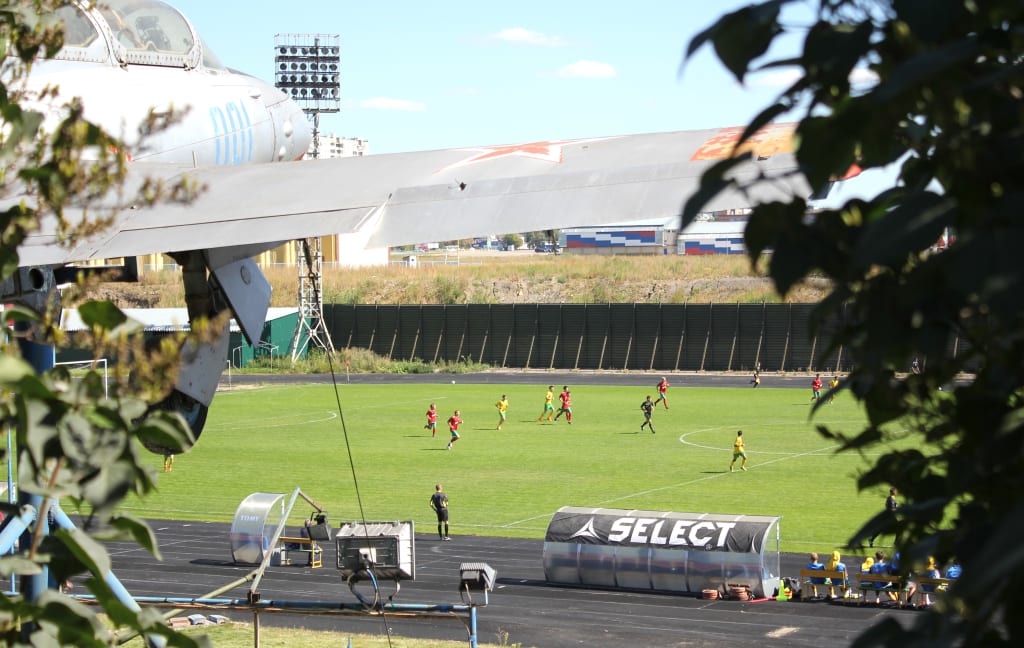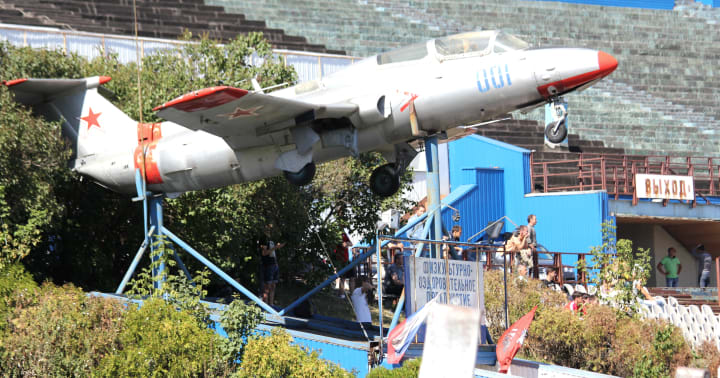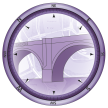In the shadow of Stalin
Fighter planes and tank traps at Moscow's strangest stadium

A Soviet fighter jet launches itself from the stand over the away team’s bench. Players warm up amid heavy artillery. Tanks patrol the car park and, legend has it, there’s a top secret metro line to the Kremlin down below. Amid the rusting military hardware there’s an eerie hum from a PA system long out of use. Welcome to Moscow’s forgotten stadium.
These days, not many people get along to the site of the projected Stalin Stadium. It’s home to Sportakademklub, an amateur team playing in the fourth tier of Russian football in front of crowds of a few dozen. Fixture information is sparse and the players – students at the nearby university of Physical Education, Sport, Youth and Tourism – achieved their greatest success of recent times at the 2015 Universiade in Korea when they formed the core of team Russia.
It makes for a surreal matchday experience. Out of Cherkizovskaya metro station but turning away from the Lokomotiv Stadium and edging around the construction sites alongside Moscow’s railway ring. Picking across a muddy car park next to a car repair lot and talking a way round a bored security guard to get into the stadium itself. Plastic chairs and tables in a dingy tunnel, with cheap tea and plastic-looking sandwiches on offer for a sparse crowd. An arena dominated by more auto workshops and that incongruous aircraft. On the field, theoretically, a local derby: Sportakademklub taking on Lokomotiv 2, the amateur team associated with Lokomotiv Moscow, a 15-minute walk away. On a baking hot day, listless spectators slump in the few areas of seating that are not overgrown with weeds. Loko take their halftime team talk outside in the shade of the bushes behind the aircraft.

But if history had followed a different path, this might have been Russia’s pre-eminent sporting arena. The original plans, drawn up in the 1930s, envisaged a 120,000-seater bowl to rival Berlin’s Olympic Stadium. By 1935 the USSR had already decided that sport was a propaganda battleground and ‘Soviet Architecture’ magazine was loudly stating the case for a showcase venue to stage large-scale events in honour of homo sovieticus. The impact of the 1936 Olympics, Leni Riefenstahl and all, underlined the idea’s importance to the politburo; while the USSR snubbed the ‘bourgeois’ Olympic movement, it urgently needed a grand home for its home-grown Spartakiad festival of sporting endeavour.
Work began in the same year. A field was laid out and a stand with 10,000 seats was built. Rumour has it there was also a 15km ‘secret’ metro line built to connect the site to the Kremlin. The supporting evidence comes from the Stalin bunker, built to house the Soviet high command during World War II and now a museum complex. The link to the Armed Forces museum explains the military hardware, but the guided tours neither confirm nor deny the existence of the underground railway.
Progress was interrupted by the war. By the time the Great Patriotic War was over in 1945 the official metro ran to this part of town, but the stadium plan was quietly dropped. Following Stalin’s death in 1953 the site fell out of favour: when Moscow was ready for its showcase arena it opened the Central V.I. Lenin Stadium, now known as Luzhniki, on the opposite side of town in 1956. Belatedly, Russia welcomed the Olympics here in 1980, and the stadium later hosted the UEFA Cup final in 1999 and the Champions League final of 2008.

The Stalin Stadium plans were forgotten, the solitary stand crumbling, until the late 1980s when it was turned into a local athletics facility. Grand designs have come and gone – one fading panel recalls the short-lived Prince Kornienko orchestra, a military band that was based here from 1998-2002 – but the stadium itself remains something of a white elephant. Even Sportakademklub’s relationship is a relatively recent one: the team functioned as a professional outfit in Russia’s second division in the 2008 season, playing at the Krylya Sovietov Stadium or out in Noviye Khimki.

The future is also uncertain. Talk of building a world-class athletics arena here has stalled. Moscow hosted the IAAF World Championship at Luzhniki in 2013 and it wasn’t long before economic and financial crises dampened the appetite for flashy new facilities. Meanwhile, following the closure of the notorious Cherkizovsky market nearby, the whole area is firmly on the developers’ radar. For now, though, Izmailovo is rare glimpse through the cracks of history: an idea whose time never came.
For more on Russian football, check out my e-book, 'Snow on the Seats', published in the build-up to the 2018 World Cup. Based on almost a decade’s experience of life in Russia, the e-book offers a glimpse at how the country, and its football, changed in the run-up to the tournament. Available for download to Kindle devices for just £1.99. Find it here
About the Creator
Andy Potts
Community focused sports fan from Northeast England. Tends to root for the little guy. Look out for Talking Northeast, my new project coming soon.






Comments
There are no comments for this story
Be the first to respond and start the conversation.